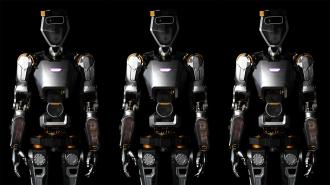Tech startup Sanctuary AI has unveiled a general-purpose robot designed to perform many workplace tasks currently handled by people — working with humans or without them.
The challenge: Robots have worked alongside people for decades, and traditionally, they’ve been incredibly specialized — a bot on a General Motors’ assembly line, for example, might move pieces of metal from one place to another over and over again.
This has meant business owners would need to purchase multiple (usually expensive) robots if they wanted to automate multiple tasks.
General-purpose robots — ones that can handle a variety of tasks — would allow employers to automate whatever is most pressing on a given day, but building a bot that can do a lot is (as you’d expect) a lot harder than building one that does one thing over and over again.
“We designed Phoenix to be the most sensor-rich and physically capable humanoid ever built.”
Geordie Rose
What’s new? Canada-based Sanctuary AI is one of several companies attempting to overcome the challenge and bring a general-purpose robot to market, and on May 16, it unveiled its sixth-generation robot, an AI-powered humanoid named “Phoenix.”
“We designed Phoenix to be the most sensor-rich and physically capable humanoid ever built and to enable [our AI platform’s] rapidly growing intelligence to perform the broadest set of work tasks possible,” said Geordie Rose, the startup’s co-founder and CEO.
The details: Phoenix is 5’7″, weighs 155 pounds, and is capable of lifting up to 55 pounds. Its human-like hands have 20 degrees of freedom and haptic sensors that allow it to perform tasks that require dexterity and precision, such as labeling packages or picking fruit.
According to Sanctuary, Phoenix also has human-like intelligence thanks to a proprietary AI control system called Carbon. It acts as the bot’s “brain” and can be trained to complete new tasks in computer simulations.
Alternatively, Phoenix can “learn from demonstration.” With this approach, a human uses a VR headset to see what the bot sees and a special rig to guide it through completing a new task.
This setup can also be used for remote control, which could enable people to work from home, prevent injuries due to physical labor, and increase the number of jobs available to people with disabilities.
Sanctuary demonstrated the potential of robot remote work with a pilot test at a Mark’s retail store near its headquarters in January. Over the course of one week, a human guided the startup’s fifth-gen general-purpose robot through 110 tasks — about 40% of the jobs a typical employee needs to be able to do at the store.
Looking ahead: The ultimate goal is still a robot that could step into the workplace and complete tasks without the need for constant human supervision, and it’s not clear how much Phoenix can do autonomously or how long it takes to train the bot on something new.
We should know more soon, though, as Sanctuary is starting to deploy its general-purpose robot at other locations near its headquarters. Customers don’t have to buy a bot to enjoy its benefits, either — they can hire one by the hour.
“Our model is focused on providing labor as a service to customers,” Ben Reed, chief marketing officer, told the Register. “The hourly pricing varies from business to business and the complexity of the tasks needing to be performed.”
We’d love to hear from you! If you have a comment about this article or if you have a tip for a future Freethink story, please email us at [email protected].






